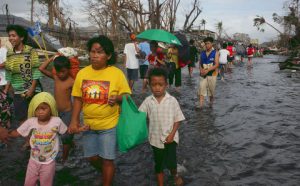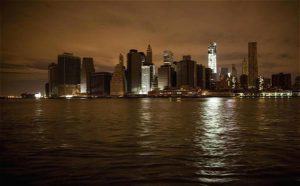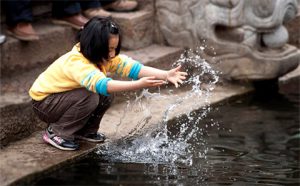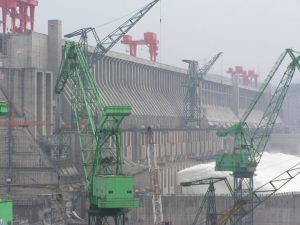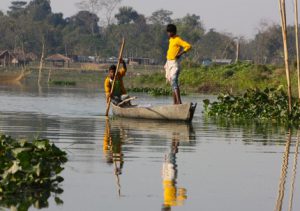Last year was the driest on record in California, and the third in a row of drought. By early February, 63% of the state was withering under “extreme” drought conditions. Towns have been running out of water, farmers and cattle ranchers are growing desperate, grape vines are dying, Sierra snowpack is a fraction of what it should be and talk of desalination plants up and down the Golden State’s coast is growing.
“The bottom line is that this storm is not going to end California’s drought,” Nancy Vogel, a spokeswoman for the state Department of Water Resources, told the San Francisco Chronicle during the brunt of the recent Pacific storm.
The year began with summery weather in Southern California. A New York Times story on February 1 captured the flipside of that balmy climate while the rest of the nation froze:
“The punishing drought that has swept California is now threatening the state’s drinking water supply,” The Times reported. “With no sign of rain, 17 rural communities providing water to 40,000 people are in danger of running out within 60 to 120 days.”
B. Lynn Ingram, a professor of earth and planetary sciences at UC Berkeley, told The Times: “We are on track for having the worst drought in 500 years.”
KPCC, Southern California Public Radio, recounted past California droughts, from 1987 to 1992 and from 2007 to 2009, but added that mega-droughts can last anywhere from several decades to a century — even longer. “We haven’t seen that since the Middle Ages,” Ingram told the station. Between 900 AD and 1400 AD, such mega-droughts were common in the region that is now California.
Scientists don’t know exactly what causes these mega-droughts, and many forecast a rainier climate for California as the globe’s average temperature continues to rise. That rain, however, is expected to evaporate more quickly as temperatures rise, and in any case more rain and less snow means valuable Sierra snowpack will be greatly diminished.
Climate change and mega droughts
In a political commentary on February 6, the Los Angeles Times’ David Horsey wrote that the ongoing drought in the West “is a reminder that civilized life is a paper-thin veneer that overlays the deep upheavals of nature. Humans carry on blithely, holding fast to the illusion that the natural world can be tamed and exploited with no unavoidable consequences. Then we get slammed by a hurricane, a flood, a tornado, a wildfire, a drought or a freezing polar vortex that lets us know how wrong we are.
“Yet, after each disaster, we forget again — which is the reason so few of us give any sustained attention to the climate change peril. It is similar to the way we think about death. We know it’s coming, but we would drive ourselves crazy if we thought about it all the time. As a result, we revert to living in the moment or counting on promises of heaven.
“With climate change, either we suspect it is too late to do anything about it or we just deny it is real. And even the vast majority of climate scientists who know it is a real phenomenon are quick with the caveat that no single weather event can be attributed to climate change with complete certainty. Nevertheless, now that extreme weather is hammering us with increasingly regularity, it is hard to argue that a profound shift is not underway.”
The ongoing drought is hammering California in several distinct ways. One is that many small rural towns are simply running out of water, like Lompico near Santa Cruz and Lake of the Woods, north of Los Angeles.
Such dire emergencies are fairly scattered, but the drought’s effects on agriculture and cattle ranching are widespread, and price increases at supermarkets nationwide appear more and more likely.
“California’s great Central Valley aquifer and the rivers that feed it, already losing water in the changing climate, are now being drained because of the drought, leaving water levels at their lowest in nearly a decade,” the San Francisco Chronicle reported on February 8. “Water experts say many farmers who depend on the huge water source beneath the valley for irrigation will have to resort to pumping water from ever deeper levels at greater costs, even as they plant crops on fewer and fewer acres as more of their land is gobbled up for development.”
As President Obama was visiting Fresno to help promote legislation offering California $300 million in aid, a New York Times story conveyed just how desperate things have become for farmers in the state’s breadbasket, the Central Valley. With huge plots of farmland becoming idle, unemployment is growing. Jobless rates in the region have skyrocketed to 45% during previous droughts — a figure many expect to see this year, The Times reported.
“It’s as worse as I’ve ever seen it, I’ll tell you that right now,” Bill Chandler, who runs a nearly 500-acre farm, growing raisin grapes, peaches and almonds, told The Times. “People would like to think a few storms will solve our problems, but that’s not even going to get us close,” he said.
Meanwhile, California ranchers have missed out on record-high US beef prices because they’ve been forced to cut their herds as pastures wither, and buying hay is unsustainable financially. “Neighbors and friends in our part of the state are selling most or all of their cows because they don’t have any other options,” rancher Kevin Kester in Central California told Bloomberg. “Unfortunately, there will be way too many of them that end up going out of business permanently.”
Ranchers in Nevada are facing similar stresses, Al Jazeera America reported on February 8.
As farmers struggle, so too does California’s $22 billion wine industry. But not just from a shortage of water. Wildfires have blanketed vineyards in Mendocino County with clouds of smoke, according to Bloomberg.
One might not think a drought could threaten desert plants, but the iconic Joshua Trees in Joshua Tree National Park are at risk too. “Some computer models predict the Joshua tree could disappear from much of the Mojave Desert, as average temperatures rise and droughts grow longer and more frequent,” said a February 2 article in the Las Vegas Review-Journal.
Salmon also face trouble. “Central Valley river levels have dropped precipitously in the past months because of a record-breaking dry spell, destroying thousands of nests — or redds — containing fertilised Chinook salmon eggs laid by spawning fish last fall,” reported the East Bay Express in Oakland on February 12.
Endangered coho salmon along the Central Coast also are struggling, the Christian Science Monitor reported February 11. “The California Coast coho salmon relies on the small creeks and streams flowing into the ocean along the coast for its life cycle,” the Monitor reported. “With most of these outlets depleted and with sandbars growing at the river mouths because of lack of runoff from the snow packs in the mountains to the east, the tiny hatchlings cannot get to the ocean nor can the adults make their way back upstream to spawn.”
The recent storm has eased the pain of the state’s ski industry, but one storm won’t make a season. Reporting from Mount Shasta near the Oregon border, CNN Money said on February 7: “Many small ski resorts in Northern California, Oregon, and Idaho that typically open in December are still closed. It’s not only killing business on the slopes but also for the hotels, restaurants and bars that depend on tourists coming to town for winter activities.”
Meanwhile, the drought has created unique challenges in the Sierra, the Fresno Bee reported February 8:
“The empty basin at Kings Canyon (south of Yosemite) is more evidence that the drought is stomping all over a wounded mountain range, parched for water after three years of drought,” the Bee reported. “The Sierra has thousands of square miles of overgrown forests, a potentially catastrophic problem set in motion decades ago by an ill-informed government policy of snuffing all fires. The unnaturally thick forests are soaking in snow moisture from any new storms now, depriving reservoirs of runoff. Even with some good storms, the stage is set to fill the sky with wildfire smoke this summer.”
Less water = less hydropower
It’s a simple equation. But California’s punishing drought is drying up the state’s ability to make electricity from water. “Few states rely on hydro as much as California, where water accounts for about 15% of the total power supply in a normal year,” reported the Sacramento Bee on February 4. “We are certainly concerned,” spokeswoman Stephanie McCorkle of the Independent System Operator, which runs the California transmission grid, told the newspaper. “We do not have a forecast for blackouts this summer as a result of the drought (but) it doesn’t mean we’re not keeping a close eye on it.”
California is much less dependent on hydropower today than in past decades, in part because power generation from solar energy has increased, Robert Weisenmiller, chairman of the California Energy Commission, told the San Jose Mercury News on February 11. Pacific Gas & Electric, for example, has a much more diverse portfolio today. The utility gets 11% of its electricity from large hydropower; the rest comes from renewable sources like solar and wind, nuclear and natural gas.
Wider economic implications
Beyond a few bright spots, including the state’s more diverse energy portfolio and the mid-February rain and snow, the consequences of California’s ongoing drought are expected to ripple across the nation. The price of California produce will likely go up, and agricultural losses in the state could weaken the national economy, according to Bloomberg. How the American West manages and distributes water must also change as the region struggles with a drier climate.
“We are at that point [where] the risks for the future are really significant,” Peter Gleick, president of the Oakland-based Pacific Institute, a nonpartisan research organisation, told Bloomberg. “We have to fundamentally change the way we manage water.”
“The drought is a stark reminder that California built the world’s 10th-largest economy, the nation’s top farming industry, and Silicon Valley, the epicenter of information technology, in a semi-arid environment that’s struggling to sustain the water needs of 38 million people,” the Bloomberg report said.
Kevin Starr, California state Librarian Emeritus, a University of Southern California historian, and the author of a multi-volume history of California entitled Americans and the California Dream, summed up the difficult future California faces in a drier, warmer region:
“They invented California through water engineering — which is great as long as you have water to engineer,” he told Bloomberg. “The greater Palm Springs area has over 700,000 people in it and what did Mother Nature intend? Probably 7,000."
This article first appeared on the Yale forum on climate change and the media.

